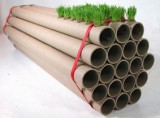The project presents the use of paper in the work of the Japanese architect Shigeru Ban who has been experimenting with materials and construction methods. His interest in paper has emerged through his research.
The long history of the architecture of paper has its roots in the traditional architecture. Only after the middle of the 20th century did the paper products start being widely used in constructions related to architecture (ie insulation, chairs, doors). Even today there are only few examples of buildings made of paper.
The paper tubes which are being used for storing and transportation have been constantly developing. New methods for making them waterproof, fire resistant and reinforced to stresses have been applied.
Shigerou Ban has been the first to use paper tubes in architecture in the exhibition for Aalto in 1986.The outcome of many experiments in laboratories is the use of paper in building the Paper House in Japan in 1995. By the end of 2006 he had completed 22 paper constructions too difficult to be classified under one category as they range in cost, construction conditions, location, and use. In order to study better and analyze his constructions, a basic categorization is attempted according to their structure and shape.
Two characteristic examples are analyzed as far as their shape and cost and time requirements are concerned (Paper Log Houses and Paper Arch).Information is given on the designs and method of construction. The shape and structure are analyzed and details of their foundations and joints are drawn so, the way the architect adjusts the elements of the construction in relation to any given limitations is clearly presented.
The choice on materials, structure, construction method and details depends on existing cost, time and local conditions. In the two examples, the conditions and requirements were totally different and the construction elements are adjusted accordingly. They belong to different morphological categories, they are both small scale constructions so the analysis is to the same extent.
